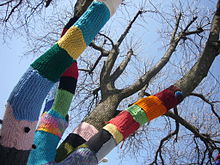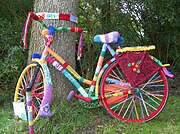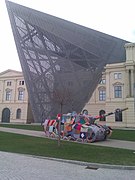Crochet is a process of creating textiles by using a crochet hook to interlock loops of yarn, thread, or strands of other materials. The name is derived from the French term crochet, meaning 'hook'. Hooks can be made from a variety of materials, such as metal, wood, bamboo, bone or plastic. The key difference between crochet and knitting, beyond the implements used for their production, is that each stitch in crochet is completed before the next one is begun, while knitting keeps many stitches open at a time. Some variant forms of crochet, such as Tunisian crochet and broomstick lace, do keep multiple crochet stitches open at a time.

Knitting is a method for production of textile fabrics by interlacing yarn loops with loops of the same or other yarns. It is used to create many types of garments. Knitting may be done by hand or by machine.
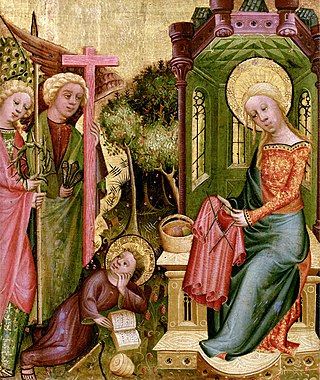
Knitting is the process of using two or more needles to pull and loop yarn into a series of interconnected loops in order to create a finished garment or some other type of fabric. The word is derived from knot, thought to originate from the Dutch verb knutten, which is similar to the Old English cnyttan, "to knot". Its origins lie in the basic human need for clothing for protection against the elements. More recently, hand knitting has become less a necessary skill and more of a hobby.

The Revolutionary Knitting Circle (RKC) is an international activist group that engages in craftivism, focusing on knitting and textile handicrafts to promote social change. Established in Calgary, Alberta, Canada, by Grant Neufeld in 2000. The group uses knitting to contrast with the ideas that protests are violent and the ways in which police handle the protests. The movement has expanded, with groups forming in various regions of the United States and Europe.

Craftivism is a form of activism, typically incorporating elements of anti-capitalism, environmentalism, solidarity, or third-wave feminism, that is centered on practices of craft - or what has traditionally been referred to as "domestic arts". Craftivism includes, but is not limited to, various forms of needlework including yarn-bombing or cross-stitch. Craftivism is a social process of collective empowerment, action, expression and negotiation. In craftivism, engaging in the social and critical discourse around the work is central to its production and dissemination. Practitioners are known as craftivists. The word 'craftivism' is a portmanteau of the words craft and activism.

Debbie Stoller is a New York Times best-selling American author, publisher, feminist commentator and knitting expert whose work includes magazines as well as books. She lives in Brooklyn, New York City. Stoller is the co-founder, co-owner and editor-in-chief of the culture magazine BUST, which she and Marcelle Karp launched in 1993.
The term "gauge" is used in knitting to describe the fineness size of knitting machines. It is used in both hand knitting and machine knitting. The phrase in both instances refers to the number of stitches per inch rather than the size of the finished article of clothing. The gauge is calculated by counting the stitches or needles across a number of inches, then dividing by the sample's width in inches.
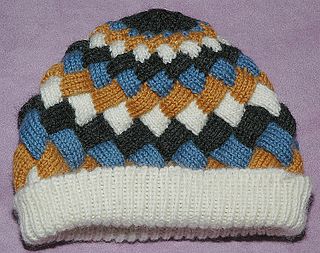
Entrelac is a knitting technique used to create a textured diamond pattern. While the result resembles basket-woven strips of knitted fabric, the actual material comprises interconnected squares on two different orientations.
Freeform crochet and knitting is a seemingly random combination of crochet, knitting and in some cases other fibre arts to make a piece that is not constrained by patterns, colours, stitches or other limitations.
Knitting clubs are a feature of the 21st-century revival of hand knitting which began in America and has spread to most of Europe. Despite the name, knitting clubs are not limited to knitting; both crochet-centered and knit-centered clubs are collectively called "knitting clubs." While knitting has never gone away completely, this latest reincarnation is less about the make-do and mend of the 1940s and 1950s, and more about making a statement about individuality and developing a sense of community.

Knitta Please, also known as simply Knitta, is the group of artists who began the "knit graffiti" movement in Houston, Texas in 2005. They are known for wrapping public architecture—e.g. lampposts, parking meters, telephone poles, and signage—with knitted or crocheted material, a process known as "knit graffiti", "yarn storming" or "yarnbombing". The mission is to make street art "a little more warm and fuzzy."
Hand knitting is a form of knitting, in which the knitted fabric is produced by hand using needles.
I Knit London is a knitting organisation based in London, England, UK, comprising a knitting group, knitting shop and knitting events. I Knit London was formed in December 2005, and is run, by Gerard Allt and Craig Carruthers.

Agata Oleksiak, known as Olek, is a Polish artist who is based in New York City. Their works include sculptures, installations such as crocheted bicycles, inflatables, performance pieces, and fiber art. They have covered buildings, sculptures, people, and an apartment with crochet and have exhibited in the United States, United Kingdom, Germany, Brazil, Turkey, France, Italy, Poland, and Costa Rica.
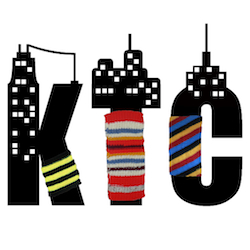
Knit the City is a group of "graffiti knitting and crochet" street artists founded in London, England in 2009. The collective is credited with being the first to go beyond the simple 'cosies' of early graffiti knitting to tell 'stitched stories', using knitted and crochet amigurumi creatures and objects in their public installations. This practice has been taken up by groups internationally.
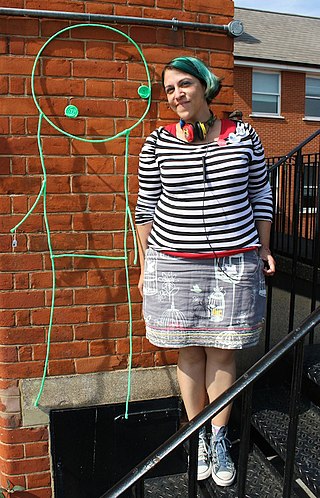
Lauren O'Farrell, also known as Deadly Knitshade, is an English author and artist. She is best known for playing a major part in the beginnings of the UK graffiti knitting street art scene, creating the Stitch London craft community and founding graffiti knitting and craft collective Knit the City.

Yarnbombing Los Angeles (YBLA) is a group of guerrilla knitters that have been collaborating since 2010. They are based at the 18th Street Arts Center in Santa Monica, California. YBLA stages public installation art and performances to help expand the definition of public art to embrace street art, Urban Interventionism and ephemera. Collaborative art making, community building, public outreach, blurring boundaries between contemporary art practices, graffiti and craft are integral components to YBLA's practice.
A knitting pattern is a set of written instructions on how to construct items using knitting.

Stephen Duneier is an American professional investment manager, strategy consultant, speaker, lecturer, author, artist and Guinness World Record holder.
